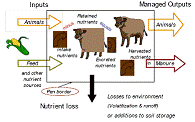Biological Systems Engineering, Department of

Department of Agricultural and Biological Systems Engineering: Presentations and White Papers
Date of this Version
September 2007
Document Type
Article
Abstract
The introduction of ASABE Standard D384.2, Manure Production and Characteristics, has created the opportunity to integrate feed management decisions and animal performance measures into nutrient planning processes. This paper introduces a software tool that integrates estimates of nutrient excretion based on the new standard with estimates of land need, labor and equipment time allocation, and economic cost and benefit for manure application. This tool will be used to evaluate the economic implications for two scenarios using beef cattle examples as a means of illustrating tool application. The first scenario will look at the impact of feeding ethanol co-products on the economics of manure application. Labor and equipment time requirements, land access needs and economic cost all increase significantly with greater inclusion rates of co-product in the diet. However, the value of the additional nutrients is potentially greater than economic cost. The second scenario explores the impact of alternative methods for determining application rate (nitrogen vs. phosphorus based application rate). For the situation evaluated, the increase in land needs was substantial but the increased time and economic costs were modest when transitioning from an N-based to a four year P-based rate. However, applying manure to supply a single year P-based rate substantially increased the equipment and labor requirements as well as the overall manure application costs.


Comments
Paper presented at International Symposium on Air Quality and Waste Management for Agriculture. CD-Rom Proceedings of the 16-19 September 2007 Conference (Broomfield, Colorado). Publication date 16, September 2007. ASABE Publication Number 701P0907cd. Copyright © 2007 R. Koelsch, R. Massey, G. Erickson, and V. Bremer.